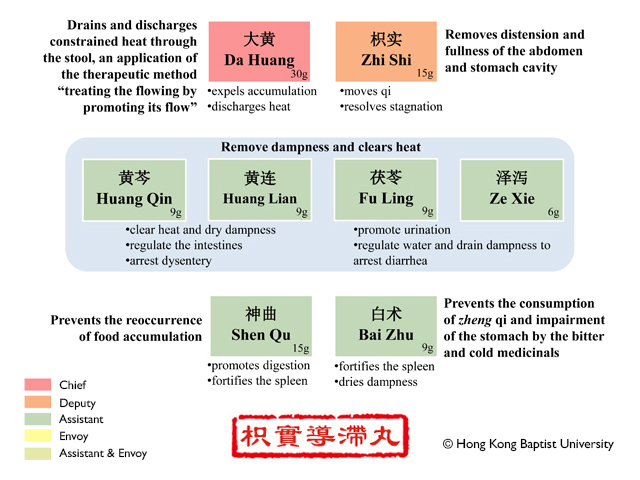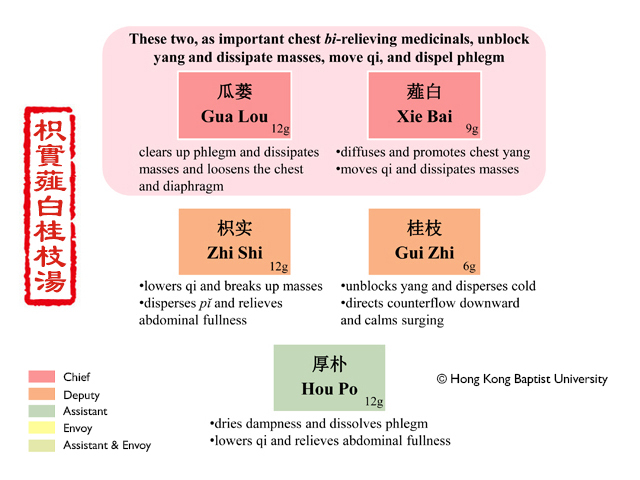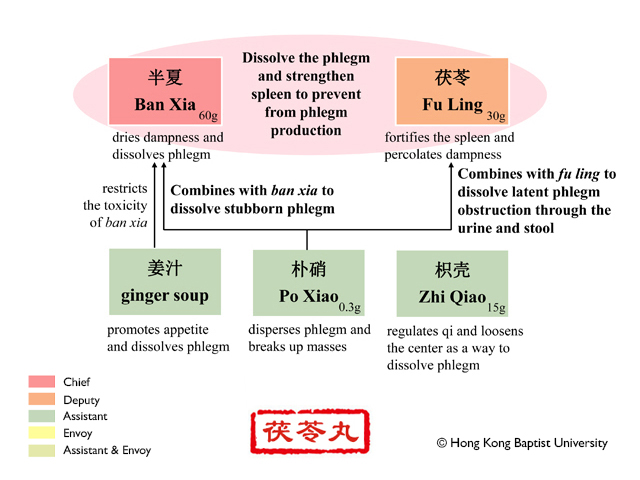| Numbering |
|
Name |
|
Combination |
|
Action |
|
Indication |
|
Thumbnail |
|
177
|
|
Immature Bitter Orange and Glomus-Dispersing Pill
|
|
Zingiberis Rhizoma; Glycyrrhizae Radix et Rhizoma Praeparata cum Melle; Hordei Fructus Germinatus; Poria; Atractylodis Macrocephalae Rhizoma; Pinelliae Rhizoma; Ginseng Radix et Rhizoma; Magnoliae Officinalis Cortex; Aurantii Fructus Immaturus; Coptidis Rhizoma
|
|
Disperses and relieves fullness, fortifies the spleen and harmonizes the stomach.
|
|
Spleen deficiency and qi stagnation with cold and heat combined, characterized by fullness below the heart, no desire to eat or drink, tiredness, lack of strength, difficult defecation, greasy, slight yellow tongue coating, and a wiry pulse.
|
|

|
|
178
|
|
Immature Bitter Orange Stagnation-Moving Pill
|
|
Rhei Radix et Rhizoma; Aurantii Fructus Immaturus; Medicata Massa Fermentata; Poria; Scutellariae Radix; Coptidis Rhizoma; Atractylodis Macrocephalae Rhizoma; Alismatis Rhizoma
|
|
Promotes digestion, removes stagnation, clears heat, and removes dampness.
|
|
Food accumulation with damp-heat, marked by distending pain of the abdomen and stomach cavity, diarrhea, constipation, dark, scanty urine, a greasy yellow tongue coating, and a deep, forceful pulse.
|
|

|
|
179
|
|
Immature Bitter Orange, Chinese Chive and Cinnamon Twig Decoction
|
|
Aurantii Fructus Immaturus; Magnoliae Officinalis Cortex; Allii Macrostemonis Bulbus; Cinnamomi Ramulus; Trichosanthis Fructus
|
|
Unblocks yang and dissipates masses, dispels phlegm and lowers qi.
|
|
Zhi Shi Xie Bai Gui Zhi Tang is indicated for chest bi caused by chest yang weakness, phlegm obstruction, and counterflow qi. The symptoms are fullness and pain in the chest, chest pain radiating to the back, panting, cough, spitting, shortness of breath, hypochondriac qi counterflowing upward to heart and chest. The coating is white and greasy, and the pulse is deep, wiry or tight.
|
|

|
|
180
|
|
Poria Pill
|
|
Poria; Aurantii Fructus; Pinelliae Rhizoma; Mirabilite
|
|
Dries dampness and moves qi, softens hard masses and dissolves phlegm.
|
|
Fu Ling Wan is applicable to patterns of phlegm hidden in the middle jiao or lingering along the channels and collaterals. Clinical symptoms may involve aching pain or spasm of the arms, being unable to lift the arms, moving pain in the arms, numbness of the hands, and edema of the four limbs. The tongue coating is white and greasy, and the pulse is deep and thin or wiry and slippery.
|
|

|

